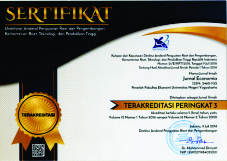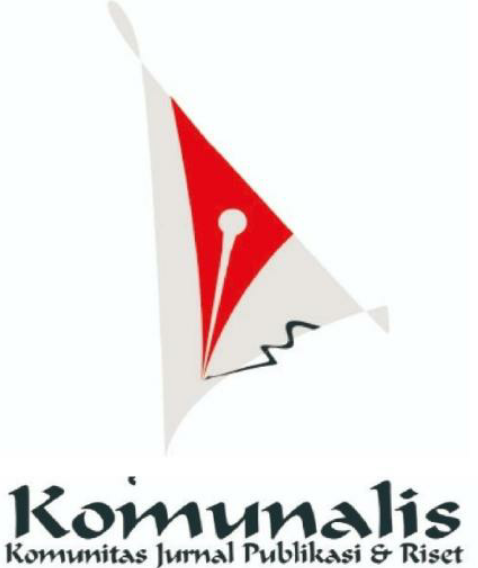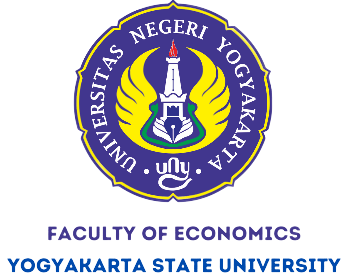The Performance of Marketing and Distribution on Supply Chain of Rice in Merauke Regency, Papua, Indonesia
Downloads
Abstract
Merauke is projected to be the rice barn in Eastern part of Indonesia. Many programmes are implemented to improve rice production. This study was conducted to figure out the number of distribution channels for rice marketing, to find out the efficient rice marketing actor, to recognise the smooth flow of product, money, and information on distribution of rice supply chain. The study was carried out in Merauke, i.e., districts of Semangga and Tanah Miring. Rice traders were sampled using the snowball technique, the initial point of farmers with 239 respondents. The results showed that there were four distribution channels of rice in Merauke. The most efficient rice marketing actor was the rice mill selling its product to Bulog partners. The pattern of the distribution of rice supply chain describing the flow of product, money and information was basically smooth, however, there was an unsmooth part in details.
Keywords:Distribution, Marketing, Rice, Supply Chain
Downloads
Amsyah, Z. (2002). Manajemen Kearsipan. Gramedia Pustaka Utama.
Arifuddin, S., Untari, U., & Widyantari, I. N. (2020). Analisis Efisiensi Saluran Pemasaran Beras. Musamuas Journal of Agribusiness (Mujagri), 02(02), 62–69. http://www.ejournal.unmus.ac.id/index.php/agri/article/view/2983/1601
Arouna, A., Soullier, G., Mendez del Villar, P., & Demont, M. (2020). Policy Options for Mitigating Impacts of COVID-19 on Domestic Rice Value Chains and Food Security in West Africa. Global Food Security, 26, 1–5. https://doi.org/10.1016/j.gfs.2020.100405
Badan Pusat Statistik Kabupaten Merauke. (2020). Kabupaten Merauke Dalam Angka. BPS Merauke. https://meraukekab.bps.go.id/publication/download.html?nrbvfeve=MGY5ZTVkYjkwZmU5ZTUyNTRlNWJiN2I3&xzmn=aHR0cHM6Ly9tZXJhdWtla2FiLmJwcy5nby5pZC9wdWJsaWNhdGlvbi8yMDIwLzAyLzI4LzBmOWU1ZGI5MGZlOWU1MjU0ZTViYjdiNy9rYWJ1cGF0ZW4tbWVyYXVrZS1kYWxhbS1hbmdrYS0yMDIwLS1wZ
Baloch, M. A., & Thapa, G. B. (2018). The Effect of Agricultural Extension Services: Date Farmers' Case in Balochistan, Pakistan. Journal of the Saudi Society of Agricultural Sciences, 17(3), 282–289. https://doi.org/10.1016/j.jssas.2016.05.007
Charisma, A. Y. (2017). Analisis Pemasaran Padi Sawah di Kabupaten Sleman. Jurnal Agritas, 1(1), 1–9. https://jurnal.ustjogja.ac.id/index.php/agritas/article/view/2801
Cheraghalipour, A., Paydar, M. M., & Hajiaghaei-Keshteli, M. (2019). Designing and Solving a bi-level Model for Rice Supply Chain Using the Evolutionary Algorithms. Computers and Electronics in Agriculture, 162(May), 651–668. https://doi.org/10.1016/j.compag.2019.04.041
Darma, R. (2017). AGRIBUSINESS : An Introduction to Agricultural Development (pertama). Libilitera Institute.
Dawe, D. C., Moya, P. F., Casiwan, C. B., & Cabling, J. M. (2008). Rice Marketing Systems in the Philippines and Thailand: Do Large Numbers of Competitive Traders Ensure Good Performance? Food Policy, 33(5), 455–463. https://doi.org/10.1016/j.foodpol.2008.02.001
Fahad, S., Adnan, M., Noor, M., Arif, M., Alam, M., Khan, K. I. A., Ullah, H., Wahid, F., Mian, I. A., Jamal, Y., Basir, A., Hassan, S., Saud, S., Amanullah, Muhammad, R., Wu, C., Khan, M. A., & Wang, D. (2019). Rice Responses and Tolerance to Metal/Metalloid Toxicity. In Elsevier. Elsevier. https://doi.org/10.1016/B978-0-12-814332-2.00014-9
Gebre, G. G., Isoda, H., Amekawa, Y., Rahut, D. B., Nomura, H., & Watanabe, T. (2021). Marketing Efficiency among Gender-Based Decision-Making Farm Households in Southern Ethiopia. Journal of International Food & Agribusiness Marketing, 33(2), 1–26. https://doi.org/10.1080/08974438.2021.1911906
Handschuch, C., & Wollni, M. (2016). Traditional Food Crop Marketing in Sub-Saharan Africa: Does Gender Matter? Journal of Development Studies, 52(3), 343–359. https://doi.org/10.1080/00220388.2015.1068289
Jamhari, & Yonekura. (2003). Eficiency of Rice Distribution Betwen Margokulon Village and Yogyakarta in Hayashi, Y. et al. Gadjah Mada University Press.
Jukanti, A. K., Pautong, P. A., Liu, Q., & Sreenivasulu, N. (2020). Low Glycemic Index Rice"”a Desired Trait in Starchy Staples. Trends in Food Science and Technology, 106, 132–149. https://doi.org/10.1016/j.tifs.2020.10.006
Komatina, N., Nestić, S., & Aleksić, A. (2019). Analysis of the Performance Measurement Models According to the Requirements of the Procurement Business Process. International Journal of Industrial Engineering and Management, 10(3), 211–218. https://doi.org/10.24867/IJIEM-2019-3-241
Limbong, W. H., & Panggabean, S. (1985). Pengantar Tata Niaga Pertanian. Institut Pertanian Bogor.
Matin, M., Baset, M., Alam, Q., Karim, M., & Hasan, M. (2008). Mango Marketing System in Selected Areas of Bangladesh. Bangladesh Journal of Agricultural Research, 33(3), 427–438. https://doi.org/10.3329/bjar.v33i3.1602
Mgale, Y. J., & Yunxian, Y. (2020). Marketing Efficiency and Determinants of Marketing Channel Choice by Rice Farmers in Rural Tanzania: Evidence from Mbeya Region, Tanzania. Australian Journal of Agricultural and Resource Economics, 64(4), 1239–1259. https://doi.org/10.1111/1467-8489.12380
Musara, J. P., Musemwa, L., Mutenje, M., Mushunje, A., & Pfukwa, C. (2018). Market Participation and Marketing Channel Preferences by Small Scale Sorghum Farmers in Semi-Arid Zimbabwe. Agrekon, 57(1), 64–77. https://doi.org/10.1080/03031853.2018.1454334
Nahumury, M. A. ., & Widiastuti, M. M. . (2015). Kajian Rantai Pasok Beras di Distrik Tanah Miring Kabupaten Merauke. Agricola, 5(1), 32–46. http://ejournal.unmus.ac.id/index.php/agricola/article/viewFile/409/313
Nguyen, H. M., Demont, M., & Verbeke, W. (2021). Inclusiveness of Consumer Access to Food Safety: Evidence from Certified Rice in Vietnam. Global Food Security, 26(2), 1–9. https://doi.org/10.1016/j.gfs.2021.100491
Panda, R. K., & Sreekumar. (2012). Marketing Channel Choice and Marketing Efficiency Assessment in Agribusiness. Journal of International Food and Agribusiness Marketing, 24(3), 213–230. https://doi.org/10.1080/08974438.2012.691812
Purwono, J., Sugyaningsih, S., & Priambudi, A. (2013). Analisis Tataniaga Beras di Kecamatan Rogojampi Kabupaten Banyuwangi. Jurnal Neraca, Ekonomi Dan Bisnis, 7(2), 136–150. https://jurnal.ustjogja.ac.id/index.php/agritas/article/view/2801
Rahman, S. M., Takeda, J., & Mohiuddin, M. (2006). Rice Farmers' Marketing Efficiency in Southwestern Part of Bangladesh. In Journal of Applied Sciences (Vol. 6, Issue 9, pp. 2043–2050). https://doi.org/10.3923/jas.2006.2043.2050
Saputro, E., Widyantari, I. N., & Nahumury, M. A. I. (2020). Efesiensi Pemasaran Sawi Hijau Tanah miring. Musamus Journal of Agribusiness, 3(1), 32–45. http://www.ejournal.unmus.ac.id/index.php/agri/article/view/3274/1787
Sari, R. K. (2014). Analisis Impor Beras di Indonesia. Economics Development Analysis Journal, 3(2), 320–326. https://doi.org/10.15294/edaj.v3i2.3838
Septiadi, D., & Joka, U. (2019). Analisis Respon dan Faktor-Faktor yang Mempengaruhi Permintaan Beras Indonesia. Agrimor, 4(3), 42–44. https://doi.org/10.32938/ag.v4i3.843
Soullier, G., Demont, M., Arouna, A., Laní§on, F., & Mendez del Villar, P. (2020). The State of Rice Value Chain Upgrading in West Africa. Global Food Security, 25, 1–10. https://doi.org/10.1016/j.gfs.2020.100365
Sudiadnyana, I. K. H. (2015). Analisis Efisiensi Saluran Pemasaran Komoditas Anggur di Desa Banyupoh Kecamatan Gerokgak Tahun 2014. Pendidikan Ekonomi Undiskha, 5(1), 2–10. https://media.neliti.com/media/publications/5373-ID-analisis-efisiensi-saluran-pemasaran-komoditas-anggur-di-desa-banyupoh-kecamatan.pdf
Sudiyono. (2002). Pemasaran Pertanian. UMM Press Malang.
Supriatna, A. (2005). Analisis Sistem Pemasaran Gabah/Beras ( Studi Kasus Petani Padi di Sumatra Utara ). Jurnal Sosial Ekonomi Pertanian(SOCA), 5. https://ojs.unud.ac.id/index.php/soca/article/view/4074/3063
Van Ha, P., Nguyen, H. T. M., Kompas, T., Che, T. N., & Trinh, B. (2015). Rice Production, Trade and the Poor: Regional Effects of Rice Export Policy on Households in Vietnam. Journal of Agricultural Economics, 66(2), 280–307. https://doi.org/10.1111/1477-9552.12087
Widyantari, I. N., Jamhari, Waluyati, L. R., & Mulyo, J. H. (2018). Does the tribe affect technical efficiency? Case study of local farmer rice farming in Merauke regency, Papua, Indonesia. International Journal of Mechanical Engineering and Technology, 9(11), 37–47.
Widyantari, I. N., Jamhari, Waluyati, L. R., & Mulyo, J. H. (2019). Case study of farming from transmigrants and local farmers in the district of Semangga and Tanah Miring, Merauke Regency, Papua. International Journal of Civil Engineering and Technology, 10(2).
Widyantari, I. N., Jamhari, Waluyati, L. R., & Mulyo, J. H. (2020). Data Envelopment Analysis for Measurement the Performance of Rice Millings in Merauke Regency , Papua , Indonesia. EurAsian Journal of BioSciences, 14(2), 6261–6265.
Widyantari, I. N., & Maulany, G. J. (2020). The Location Quotient Approach for Determination of Superior Food Crop Commodity in Merauke Regency , Province of Papua , Indonesia. EurAsian Journal of BioSciences, 14(2), 7111–7117. http://www.ejobios.org/article/the-location-quotient-approach-for-determination-of-superior-food-crop-commodity-in-merauke-regency-8478
Zaeroni, R., & Rustariyuni, S. D. (2016). Pengaruh Produksi Beras, Konsumsi Beras Dan Cadangan Devisa Terhadap Impor Beras di Indonesia. E-Jurnal Ekonomi Pembangunan Universitas Udayana, 5(9), 993–1010.
Copyright (c) 2023 Jurnal Economia

This work is licensed under a Creative Commons Attribution 4.0 International License.















